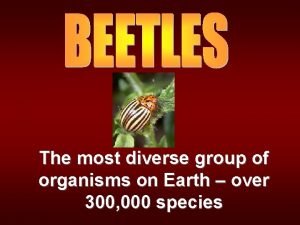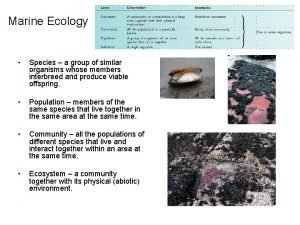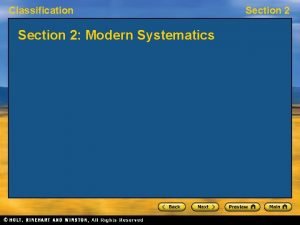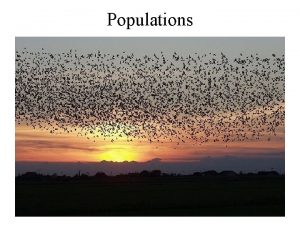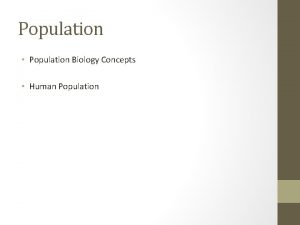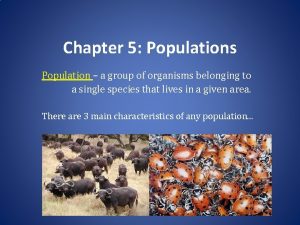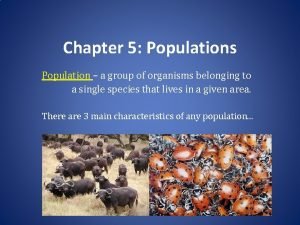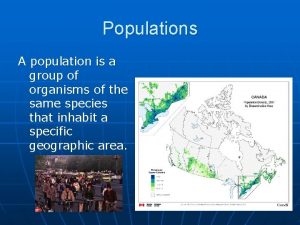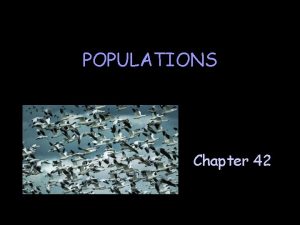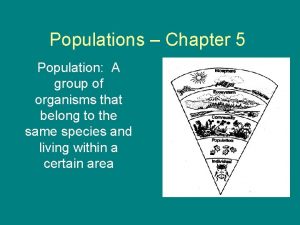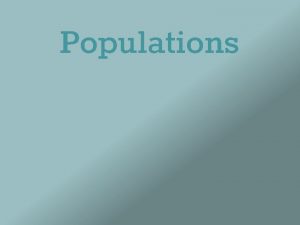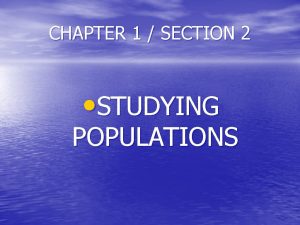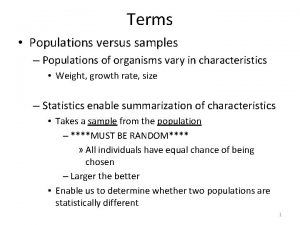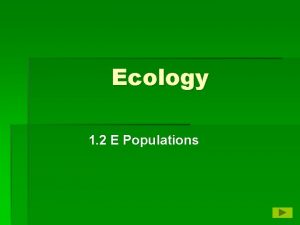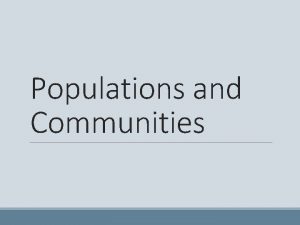POPULATIONS Population a group of organisms of the





















- Slides: 21

POPULATIONS • Population – a group of organisms of the same species that live in a specific geographical area and interbreed

CHARACTERISTICS OF POPULATIONS Geographic Distribution • Where they live Population Density • The number of individuals in an area Growth Rate • Populations may increase, decrease, or stay the same

FACTORS INFLUENCING GROWTH # of Births # of Deaths # of Individuals that enter or leave a population • Immigration – movement of individuals into an area • Emigration – movement of individuals out of an area

WHAT DO YOU THINK WILL HAPPEN TO POPULATION SIZE IF…. • • • Population Increases The birth rate is higher than the death rate? Population Decreases The death rate is higher than the birth rate? Population Stays the same The birth rate equals the death rate? Population Decreases Individuals emigrate from the population? Individuals immigrate to the population? Population Increases

POPULATION GROWTH • Exponential growth – occurs when individuals in a population reproduce at a constant rate J – Shaped • This can only happen under ideal conditions with unlimited resources (food, water, shelter, space).

POPULATION GROWTH • Logistic growth – a population that starts with a minimum number and reaches a maximum depending on the carrying capacity of the habitat S - shaped

EXPONENTIAL GROWTH J - Shaped Draw the growth curve:

LOGISTIC GROWTH S - shaped Draw the growth curve:

CARRYING CAPACITY • Carrying capacity – the largest population that an environment can support at any given time

CARRYING CAPACITY • If a population grows over its carrying capacity, resources will be depleted, and the population will crash (because most of the population starves).

LOGISTIC GROWTH S - shaped Draw the growth curve:

EXPONENTIAL GROWTH

EXPONENTIAL GROWTH

EXPONENTIAL GROWTH


WHAT LIMITS A POPULATION’S GROWTH? • Limiting Factors – factors that cause population growth to decrease • Density-Dependent Limiting Factors: depends on population size • Examples: competition, predation, parasitism, and disease • Density-Independent Limiting Factors: affects all populations in similar ways, regardless of the population size • Examples: unusual weather, natural disasters, seasonal cycles and certain human activities – such as damming rivers and clear-cutting forests

CHECKS & BALANCES ACTIVITY This Photo by Unknown Author is licensed under CC BY-SA

OH DEER!

PREDATOR/PREY RELATIONSHIPS

PREDATOR/PREY RELATIONSHIPS

• https: //www. youtube. com/watch? v=Pdwnf. Pur. Xcs&featur e=related
 Why do organisms interact with other organisms
Why do organisms interact with other organisms Unicellular and multicellular.
Unicellular and multicellular. Chapter 4 population ecology test answer key
Chapter 4 population ecology test answer key Section 1 population dynamics
Section 1 population dynamics Population ecology section 1 population dynamics
Population ecology section 1 population dynamics Population ecology section 1 population dynamics
Population ecology section 1 population dynamics Most diverse group of organisms
Most diverse group of organisms Marine ecology
Marine ecology Section 2 modern classification
Section 2 modern classification Hát kết hợp bộ gõ cơ thể
Hát kết hợp bộ gõ cơ thể Bổ thể
Bổ thể Tỉ lệ cơ thể trẻ em
Tỉ lệ cơ thể trẻ em Gấu đi như thế nào
Gấu đi như thế nào Tư thế worm breton là gì
Tư thế worm breton là gì Hát lên người ơi
Hát lên người ơi Kể tên các môn thể thao
Kể tên các môn thể thao Thế nào là hệ số cao nhất
Thế nào là hệ số cao nhất Các châu lục và đại dương trên thế giới
Các châu lục và đại dương trên thế giới Công thức tính thế năng
Công thức tính thế năng Trời xanh đây là của chúng ta thể thơ
Trời xanh đây là của chúng ta thể thơ Cách giải mật thư tọa độ
Cách giải mật thư tọa độ






